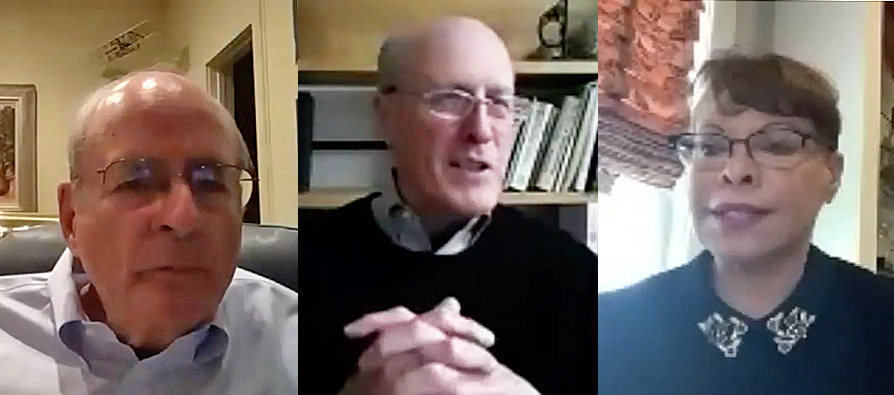Face to Face with Leadership in Crisis
Leading off his weekly web-based program Virtual Face to Face with Dr. Bruce Jarrell on April 23, University of Maryland, Baltimore (UMB) Interim President Bruce E. Jarrell, MD, FACS, got right to the heart of crisis management on the corporate level. “Norm, I remember you used to tell me you kept a list in your pocket of the 10 most important things that could destroy your company,” he said to former Lockheed Martin CEO Norman R. Augustine, MSE, who also is UMB’s President’s Distinguished Scholar. “Was your company resilient when that disruptive event occurred?”
Augustine said that two of his corporate doomsday scenarios did actually occur. He explained one was the collapse of the Soviet Union in 1989, which ended the Cold War. “It was a such a great event for the world, but for the aerospace industry, it was a disaster,” he said, explaining that it wiped out 640,000 industry jobs. The better short-term strategy, Augustine offered, might have been to break up the company and sell off some of the pieces. In the end, Lockheed Martin used the opportunity to buy up smaller, strategically important companies. Augustine’s company emerged stronger and better prepared for the future.

Bruce Jarrell (center) interviews Norman Augustine and Linda Gooden.
Members of the UMB community entered the discussion with a wide range of questions for Jarrell, Augustine, and fellow panelist Linda R. Gooden, MBA, chair of the University System of Maryland (USM) Board of Regents and retired executive vice president of Lockheed Martin Information Systems and Global Services. In that capacity, Gooden led the largest information technology provider to the federal government for more than a decade.
“During this time of pandemic, we are going to online education, therefore we must be creative,” said Jose Bosio, BDS, MS, clinical associate professor, division chief, program director in the Department of Orthodontics and Pediatric Dentistry at the University of Maryland School of Dentistry. “Unfortunately, every action requires an analysis of risk. In your opinion, how long will it take for effective actions to be taken without fear of making the wrong decisions in every level of administration?” he asked.
“The [USM] chancellor and I met with the faculty council recently, and I was impressed with the innovation demonstrated in the area of remote learning,” Gooden replied. “I think that with every crisis there will be people who come up with ingenious, unique, and innovative solutions, and many of those solutions will turn out to be a lot better than the traditional solutions. Now you’re not going to get anywhere if you’re not willing to take some risk.”
Augustine agreed that the risk has to match the benefit, and he illustrated that point with a story. He explained that Lockheed Martin used to build the huge fuel tanks that were the structural backbone of the space shuttles. “So big,” he said, “I once calculated that if you put that fuel tank from the space shuttle on its side, it was so big the Wright brothers’ flight could have literally taken place inside of it.”
After building 10 of those tanks for NASA, Lockheed Martin got a new contract, this time to reduce the weight of each tank by 8,000 pounds to allow for increased cargo. Engineers struggled to reduce the weight, eventually removing 7,200 pounds — not enough.
“One day there was a group of engineers standing around a drawing table debating on how do we get 800 pounds out of here. Turned out there was a young fellow from the factory who was walking by and happened to hear the debate and at some point he said, ‘Why don’t you not paint the fuel tank white?’ ” With a smile, Augustine went on: “There was silence, and finally one of the engineers said, ‘Well, space hardware is always painted white.’ ” It turned out that just the paint used on the fuel tanks weighed 800 pounds.
“He probably thought he was taking a risk” by speaking up, Augustine said.
By the end of the discussion, thoughts returned to the current crisis and a question about practical steps for the audience. “I wonder if you can share with us today some effective ways, tips, or steps that a leader can take when dealing with a crisis like this that everyone can take home from our discussion today,” asked Aicha Moutanni, lab specialist at the University of Maryland School of Nursing.
“I think the most important thing is to remember why we’re all here and particularly in the UMB setting,” Gooden said. “You’re here for the safety and health of all students and for all of the work you do to help in the medical system. And so, when you think of it that way, your mission is extremely important.”
“We get to the other side of every crisis eventually, and it’s just making sure that we’re communicating effectively with people, that we’re staying true to our values and our culture, and that we are in fact staying on top of the facts,” Gooden added. “In this particular crisis, that we’re following all of the CDC recommendations so that we’re not infecting others if we turn out to be asymptomatic. This is a unique crisis in that it’s an illness and that any of us can be affected by it, and so keeping a level head, staying focused, and making sure that we’re doing the things that all of the people tell us to do will help keep people safe is really, really important.”
Watch the entire program in the video below.



